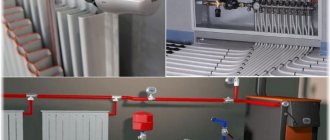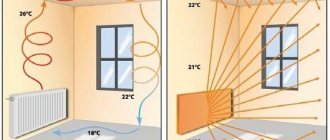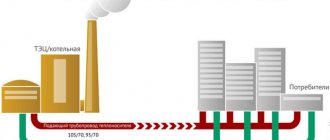Heating is something that every person thinks about before buying a house or apartment. The people who compile the ratings claim that this criterion is in second place, even surpassing cost. There are other data that indicate that water and heat consumption in Russian houses is several times higher than European indicators.
Central heating of apartments does not bring the desired result. And it's a matter of interruptions in heating and hot water. But the cost of utilities only increases. In addition, the entire pipeline system in Russia is very worn out, including boiler equipment. As a result, when calculating heat loss, the figure comes out to 50 percent, which is very high.
It’s easy to understand that everyone is starting to think about apartment heating. This is a way out of this situation. Because it will be profitable from a financial point of view and more efficient in terms of heat supply. This method of autonomous heat supply for apartment buildings is the best today.
What is it about?
Before equipping your apartment with such an additional heat source, it is worth understanding how it works. Apartment heating is the creation of a mini-boiler room in each individual sector. After this, residents can individually set their desired temperature and change it as needed. For such an arrangement you will need:
- Boiler. Depending on the area of the apartment, you need to make a reserve of 20 percent so that the unit does not work at its limit. Today there are a variety of models on sale with the desired set of functions.
- Devices for recording fuel consumption. This includes meters and other heating elements.
- Air capture equipment. This is required during the combustion process.
- Pipes for removing smoke and gases.
Peculiarities
Apartment heating is gaining momentum in Russia, so today we can say exactly what the advantages and disadvantages are. Generally speaking, there are more pros than cons. To understand this issue, in 2000, the Russian State Construction Committee conducted some research in which autonomous heating was used in the construction of apartment buildings.
Today there are such houses in Smolensk and St. Petersburg. Wall-mounted boilers began to be actively used in other cities, because it was profitable. Even with a commercial building, this was taken as a basis. Because people understood that in this way it was easier to create the desired microclimate in the house and not overpay. After all, everyone has their own settings for recording heat consumption.
As a result, such experiments brought a lot of positive results, and living in apartments became more comfortable. After this, documentation appeared on the basis of which it was possible to build such houses. Nowadays, autonomous heating is at the peak of popularity. In addition, the regions appeared their own regulatory documents, according to which the apartment heating system was completely legalized.
As a result, the number of houses with such heat supply increases every year. This happens in different regions and cities. From this it is clear that efficiency is present at every stage. It is in this way that problems of the housing and communal system can be solved. At the same time, today they are even reconstructing old buildings.
In what cases is the consent of neighbors not required?
It also happens that the issue can be resolved without a general house meeting. This happens when the heating system in the house and all its elements are not designated by documentation as common property. But even this fact does not mean that independent shutdown will be natural.
In this case, it is necessary to obtain permission from a local organization that provides resource supply services, since during the reconstruction the house registration certificate will need to be edited.
Its third section, in particular, lists detailed information about the heating system. The law regards any change and installation as a technical change that must be included in the technical passport.
The procedure goes better if all residents of the house want to connect individual heating.
Then, at a general vote in the apartment building, an appropriate decision is made, signatures are collected on the consent of all owners and technical documentation is prepared.
What does the user get?
General positive aspects:
- The consumer himself keeps track of and controls the heating level of water and premises. There are no interruptions, warm water all year round, heating can be turned on at any time.
- An apartment heating system allows you to save gas, but at the same time maintain the desired heat level. In addition, it becomes possible to reduce the numbers in payment receipts. And today these indicators are of great importance for every person.
- It is easier to build an apartment building with individual apartment heating, because there is no need to cut into the central pipe, obtain permission and build a new main. If there is a stable gas supply, construction can take place in any, even the most remote, territories. The payback on such a structure occurs quickly. All developers are guided by this, as they manage to save a decent amount.
- Apartment gas heating is an environmentally friendly solution that many people choose. Boilers with a closed combustion chamber are installed in apartments, so there is no need to install additional ventilation. This installation operates independently, since everything necessary is available inside. Combustion products immediately go outside and dissipate, while modern installations are designed to meet all acceptable criteria and safety for the environment.
A gas boiler
It’s worth saying right away: gas REALLY is the cheapest source of heat for heating. At least for now. Let's weigh the pros and cons of this scenario.
Advantages
Practice shows that the difference in payment between centralized heating and autonomous heating using gas ranges from 2 to 3 times at the same temperature conditions.
Why is central heating so expensive?
It’s clear that the first, almost unconditional reflex is to blame greedy officials for everything. However, tariffs for heat in housing and communal services have, in addition to someone’s ill will, quite sound justifications.
- They pay for gas, which is used to produce heat by boiler houses and thermal power plants, at a higher rate than private individuals.
- No one has canceled the depreciation of equipment. Boilers require periodic repair and maintenance; In addition, the tariffs are forced to include planned replacement of equipment.
- Annual repairs and planned replacement of heating mains also put a burden on your pocket.
- Your home heating system needs to be serviced. This expense item includes the planned replacement and repair of risers, elimination of radiator leaks, inspection and replacement of valves in the elevator assembly, checking and boring of nozzles, monitoring the temperature conditions of the elevator and a hundred other different works that we often do not notice.
- Finally, all heat losses: on a heating main with stripped thermal insulation, in an open entrance, even in the thermal power plant itself are paid for... that’s right, you too.
Another important advantage that an apartment heating system has is independence. I think everyone has had to freeze at home while waiting for the heating to start and suffer from stuffiness on a hot April day. Autonomous heating in an apartment means that you provide the temperature you need at any time, depending ONLY on your own comfort.
Early autumn frost. Residents of apartment buildings are freezing. Owners of autonomous heating systems chuckle.
Flaws
Of course, it could not have happened without them.
- The use of exhaust combustion products through a coaxial air duct to the facade of the house means that it is better not to open the windows again. The soot that is inevitable during gas combustion will fall inside the premises.
However: in houses whose design was initially optimized for individual heating, a more complex boiler operation scheme is often found: air is taken from the facade, and combustion products are discharged into a ventilation duct, the throughput of which allows all boilers along the riser to operate at full power simultaneously.
The photo shows just such a new building. Channels for air intake are installed on the façade.
- Gas consumption in the corner and middle apartments of the house will vary. In the case of central heating, this, albeit somewhat comical, problem of social inequality is solved by the same amount of payment for heat.
- The greater the total amount of gas equipment in the building, the greater the likelihood of a gas leak with the corresponding consequences. Yes, modern boilers are much safer than Soviet-style gas stoves; however, in general the gas is still explosive.
Benefits for the developer
It was the companies that build houses that received benefits, which began to bring them less expenses:
- There is no need to lay expensive heating mains and create heating points.
- The installation of metering devices is not carried out.
- Houses are being built in any area of the city where there is an uninterrupted gas supply.
Companies that provide maintenance also have their advantages in such construction:
- It is easy to maintain gas boilers. This is a big plus for the relevant organizations.
- There is no need to disrupt the operation of the heating system in each apartment when replacing pipes during renovation or redevelopment of the premises. Everyone takes an individual approach and maintenance of their devices.
- Payment is made according to individual meters, which is easier to control. Debt is dealt with only with one user, and not with all residents of an apartment building. It is very comfortable.
In addition, executive authorities also benefit. They have their positive sides. These include:
- There is no need to build a central heating supply line, which means that the funds remain in the budget.
- There is no need to apply for subsidies.
- In heating networks there is no need to look for heat losses and reimburse costs.
- All responsibility falls on the apartment owners regarding fees and maintenance.
Apartment heating supply in Russia
In Russia, apartment-by-apartment heat supply has only been developing for a few years, and so far the attitude of representatives of the domestic housing and communal services sector and developers is quite wary. At the same time, the lucky ones who already have such a system installed in their homes are more than satisfied with both its performance and the size of utility bills. They have to pay two to three times less for heat and hot water than owners of apartments with centralized heating.
The problems of introducing autonomous heat supply in our country were discussed at the First Conference of specialists in the design of heat supply systems, held in September last year in Sochi. It was organized by the SantekhNIIproekt design and research institute, part of the Ministry of Regional Development, and the Russian branch of the Merloni Termosanitari company (Ariston heating equipment).
Why is it not profitable for investors and developers to install more economical and convenient autonomous systems in new buildings? Is apartment living suitable for all Russian regions? These and other questions were answered by the Honored Builder of Russia, the director of SantekhNIIproekt, Albert Yakubovich Sharipov, and the chief heating engineer of the same institute, Aleftina Semenovna Bogachenkova.
— How would you characterize the current state of Russian heat supply?
A. Ya. Sharipov: — In most Russian cities, modern centralized heating infrastructure was dominant with planned economic management and government funding. With the beginning of market reforms in the 90s. minimal attention was paid to public utilities, and now the wear and tear of heating networks and boiler equipment, according to some data, has reached 70%. So the state of domestic heat supply systems currently poses a serious problem. At the height of the heating season, many populated areas may be left without heat due to accidents, and there is no need to tell what this entails in the conditions of the Russian winter.
Of course, there are regions in which the condition of the centralized heating system is maintained at a quite decent level. These are, as a rule, large cities: Moscow, St. Petersburg, Yekaterinburg, Omsk. With qualified operation and sufficient funding, such heating networks can “live” for quite a long time. But in those regions where deterioration has exceeded a critical level, replacing heating networks and equipment requires enormous capital expenditures. And “patching holes” will not lead to anything good: in 5–10 years all the problems will return. Therefore, here we have to talk not about the reconstruction of centralized systems, but rather about the structural restructuring of heat supply circuits and systems.
— We have all heard about the current depressing state of heating networks and equipment. But is the Russian housing and public utilities sector ready to switch to autonomous heat supply technologies?
A. S. Bogachenkova: — The need to reform the Russian housing and communal services became obvious to everyone several years ago. But, unfortunately, executive authorities in the center and locally saw the restructuring of public utilities mainly in tariff regulation. It was then that we started talking about autonomous systems and we were given the “green light” to introduce such a heating supply option, including “apartment-by-apartment”. Since then, we have repeatedly been convinced that we have taken the right path. When developing apartment heating systems, the main thing for us was to create an alternative to the traditional centralized system - where it is economically profitable. But it’s worth noting that we are not “centralization gravediggers,” as we were once called. On the contrary, I believe that maintaining and developing a centralized heating system is a reasonable step. But this approach can be used where the system is based on combined heat and power generation (cogeneration). In other cases of centralized heating (for example, based on block and district gas boiler houses), it often does not make much sense to maintain a worn-out structure. In such cases, it is more rational to build the heat supply anew, based on modern technologies. Therefore, in each case it is necessary to consider a specific situation and, based on it, calculate possible options.
— In your opinion, what real benefits will the introduction of apartment heating bring?
A. Ya. Sharipov: — We can name many problems that would be successfully resolved with the introduction of “apartment apartments” or other types of autonomous heat supply. The development of communal infrastructure does not keep pace with the intensive construction of multi-storey residential buildings. Often they cannot be put into operation because there is no heat, electricity, etc. The fact is that during complex development, connecting new buildings to an existing thermal power plant or to a new district boiler house is possible only when these sources have already been built. With insufficient funding, this is very difficult to accomplish before the construction of the residential area is completed. Where to look for a way out? Probably in various autonomous heat supply options.
Currently, SantekhNIIproekt is developing heat supply projects for three districts of Moscow: Kurkino, Rublevo-Arkhangelskoye (where, most likely, a combined system will be adopted) and Bolshoye Domodedovo. We need to decide how to organize the engineering infrastructure, taking into account the technical, economic and environmental aspects of the problem and the construction time frame. The optimal solution here could be attached boiler rooms or apartment-by-apartment heat supply.
A. S. Bogachenkova: — Nowadays, a lack of heat is felt in most regions, even in relatively prosperous Moscow. The explanation for this is the simplest - the existing heat supply system is worn out. The capacities installed in boiler houses have exhausted their reserves and cannot provide increasing loads. We want to create a reliable system that would allow people to have heat without interruptions and would not be financially burdensome.
An apartment-by-apartment heating system in some cases turns out to be more expensive at the capital construction stage, but significantly cheaper in operating costs. Residents pay two to three times less than under a traditional centralized system. This has been proven in the example of the Belgorod region, where a program to introduce apartment heating in new buildings has been in place for more than five years. There, more than 5 thousand apartments are already equipped with such systems based on gas boilers. Another example is the active implementation of apartment heating in rural areas of the Republic of Tatarstan.
— Tell me, why then are our public utility workers opposed to autonomous heating and “apartment apartments” in particular? Are they not ready to accept new methods or do they see such a system as economically unprofitable?
A. S. Bogachenkova: “We did a great job when we achieved regulatory support for the design and construction of autonomous automated heat supply sources. But with the widespread implementation of this scheme in the domestic housing and communal services, a lot of problems will arise, and above all in maintenance. Let's say an investor has attached an autonomous automated boiler room to his house. But to whom should this boiler house be handed over to the balance sheet? It turns out that no one needs it: in different boiler houses, as a rule, equipment from different manufacturers is installed, and this scares off those who would undertake service maintenance - each type of equipment requires “its own” spare parts, and this is very inconvenient.
In addition, for some reason many are afraid of the “apartment”. They are frightened by the location of the mini-boiler room in the apartment. As a rule, it is confusing that gas is a potential source of danger, especially against the backdrop of increasingly frequent accidents in gas supply systems. But in most cases, the cause of incidents is outdated equipment (stoves and speakers) and its improper operation. In addition, today there are enough devices and means of protection that ensure proper safety: these are automatic shut-off valves, air monitoring devices that automatically stop the flow of gas in all emergency situations. Ideally, every kitchen would need to be equipped with them!
Another aspect of the problem. During the years of the transition period, the system of responsibility for the use of gas in everyday life has seriously suffered. As a result, the equipment is worn out and preventive inspections and repairs are not carried out. However, in recent years the situation has begun to improve. Gas facilities are being restructured, the network of authorized services of large gas equipment manufacturing companies is expanding - today it covers all regions of Russia. Therefore, statements about the dangers of autonomous systems are not true. But the advantages of “apartment-by-apartment” are obvious: this is the elimination of abnormal heat losses and the regulation of consumption by the meter for gas, electricity and water by the apartment owner.
A. Ya. Sharipov: — The answer to the question why a centralized system is used in new buildings, rather than apartment-by-apartment, is simple: it is not yet economically profitable for investors and developers. They pursue their own interests - to build cheaper, but sell more expensive. According to our calculations, during residential construction, 10–15% of the cost per square meter of housing should be spent on energy-saving technologies. This reduces profits. And they are not responsible for operating costs. Unfortunately, the economic mechanism is such that the consumer is not given the right to choose.
— Can apartment-by-apartment heating supply be considered the optimal choice for Russia?
A. Ya. Sharipov: — I wouldn’t say so unequivocally. In each case, appropriate calculations and comparison of the effectiveness of different options are needed. For the southern regions of the country and low-rise construction, apartment heating is, in my opinion, the most appropriate option. Generally speaking, it seems to me that it is necessary to adopt a law at the regional level that would require that when designing a heat supply system, first consider the “apartment” and only if its installation is impossible, think about another system. We have been involved in apartment heating for 15 years, developing standards and projects for it. Over the years, I have not seen a single dissatisfied user of this system. Of course, problems exist, and “apartment living” should not be seen as a panacea for all ills. However, with such a system, it becomes possible to supply heat to a newly built house at any time when it is needed. When using this system, you can heat the room at any time of the year or turn off the radiators if the temperature outside is above zero in winter. You get hot water without “preventive” shutdowns. And you pay for heat, and not for an abstract “square meter of area”, i.e. exactly as much as you spent on heating the room.
— When the topic of apartment heating comes up, many residents of high-rise buildings wonder whether they can install such a system in their apartment so that their home is always warm?
A. Ya. Sharipov: — Our institute has options for modernizing existing heat supply systems for residential buildings. For example, an interesting project is currently being implemented in the village of Lytkarino, Moscow region. A two-story attic is built over the 5-story “Khrushchev” building, the house is disconnected from the centralized heating supply and transferred to an “apartment”. But the problem is to get the consent of all the residents of this house.
The owner of an apartment in a multi-storey building, theoretically, can also install an autonomous system. But so far, unfortunately, there is no corresponding regulatory framework. It has yet to be developed. It is necessary to adopt a legislative framework so that the choice remains with the consumer, and all other structures ensure reliability and safety. In this case, the laws of the market must work fully. In general, without any doubt, there is a great future for apartment-based heat supply in Russia.
| Author: based on editorial materials Date: 03/17/2008 Stroyprofil magazine 2-1-08 Heading: heat supply. housing and communal services heating systems |
"" back
Presence of negative sides
There are many advantages, but there is always a negative side. First of all, apartment heating boilers require the removal of combustion products - smoke. Every square meter of the owner should not emit smoke into the street. This is strictly prohibited. Therefore, it will be necessary to create a single chimney. If you calculate the costs of it, it will turn out to be expensive. In addition, it will have to be built according to all the rules, and this will take a lot of time.
Such a house with apartment heating would be considered dangerous. Because in the area of each apartment there will be a boiler running on gas, and this substance is considered explosive. But when every person approaches the installation issue with all seriousness and chooses a high-quality boiler, this minus is missed.
Apartment heating
In the first case, there is centralized heating, which the homeowner intends to abandon and switch to individual heating. In this case, we are not initially talking about centralized heating.
This often happens in new buildings, when the house is not connected to the central system, and each apartment has a gas double-circuit boiler.
Apartment heating is beneficial for both the developer and the buyer.
The first saves money on risers and wiring, as well as time on completing additional documentation. The second receives housing with a choice of heating level and time when it is needed.
But there are also cases when the boiler is not pre-installed, and houses are put into operation without solving the heating issue.
Requirements
It is necessary that the unit has all the appropriate fasteners:
- Flame presence control.
- Monitoring traction and temperature indicators.
- If there is no fire, the shut-off valve should operate.
Therefore, it is better to buy boilers from those manufacturers who have been on the market for more than one year. Also, annual maintenance must be carried out by the relevant authorities, and this cannot be waived. Today, gas distribution stations not only carry out the gas supply procedure, but also offer high-quality boilers at affordable prices. In this case, they are already fully responsible for the entire process of operation of the device.
Traction
In addition, apartment heating distribution has another weak side - draft. Those who are on the lower floor receive a large flow of wind and draft, but on the upper floors it is the opposite. In addition, most often people install a 24 kW boiler in their homes, but it is too powerful. This means that the equipment itself only works at half capacity, since a two-room apartment requires a minimum of energy.
But if you use hot water frequently, you need exactly this kind of power. As a result, before purchasing, you will have to carefully calculate how much power is required. The thermoblock operates even at a reduced load, but as a result, condensation forms in the pipe if the outside temperatures are negative. It is necessary to carry out complete and high-quality thermal insulation. If this is not done, you will have to purchase additional equipment.
Although experts believe that when any equipment is added to a wall-mounted boiler, an increased level of costs arises, and this is a significant reduction in benefits. When residents install boilers in their apartments, they make adjustments to reduce power. But no one calculates the level of efficiency and gas output. This means that there may be serious body losses, which would also result in useless expenses.
Freezing
Another point is that only the apartments are heated. This means that the entrance, attic, and basement are not heated. During the cold season, freezing will occur. As a result, the service life of the building, namely its suitability for habitation, is reduced. In addition, residents in the center of the house are in an advantageous position because the heat from neighboring apartments is available to them. When the house is new, not all apartments are sold out, the walls are cold, which means there is a load on the apartment with an autonomous heat supply. And this is a plus to the indicators on the counter.
Summing up
Many people living in apartments with apartment heating are worried because not everyone treats boilers responsibly. This is a complex system that requires periodic monitoring and testing. From a legal point of view, everyone decides for themselves. Moreover, all checks must be carried out by experienced, educated specialists. This service is paid, but it will pay for itself. Because malfunctions can lead to additional figures on the accounting system.
When choosing an apartment, everyone decides for themselves what is best for them. But before you start, you should weigh all the positive and negative sides. Of course, there are many advantages, since each person decides for himself when to heat his apartment and when to turn off the heating. Removing the disadvantages is not so difficult - all this can be solved in the modern world.
You can make the transition to apartment heating yourself. Namely, lay pipes and install a boiler. As for gas, only experienced people with proper documents do this. It will not be possible to give an exact price, since everyone chooses the boiler themselves, and their prices vary. Such equipment looks neat and will not spoil the existing interior design.
Required documents
The law states that absolutely any home owner has the right to individual heating and disconnection from the central heating system.
To complete the procedure, the owner must provide:
- conclusion of an engineering company on the technical feasibility of re-equipment;
- written consent of all apartment residents;
- documents certifying the ownership of the apartment;
- technical passport of housing;
- a statement drawn up in free form.
The law also requires the provision of a project as one of the main documents in the package. The project is being developed by water and heat supply engineers.
It is also worth entrusting the project to specialists because, sooner or later, independent conversion will be fixed and dismantled with a return to the central heating center, it is good if this happens before the neighbors below are flooded due to improper wiring, installation or cutting of pipes.
The project is compiled exclusively by specialists who calculate the changes. The calculation determines what impact a future shutdown will have on the operation of the heating system in the house. In addition, specialists carry out thermal-hydraulic calculations and calculations of heat transfer from the riser.
If calculations show that it is technically possible to re-equip the heating, the project can be approved. If it turns out that the shutdown will worsen the heating results in the remaining apartments, most likely the project will not be approved.











